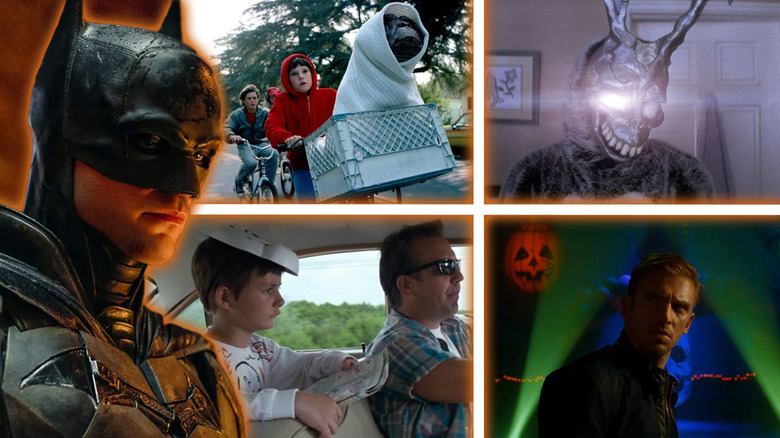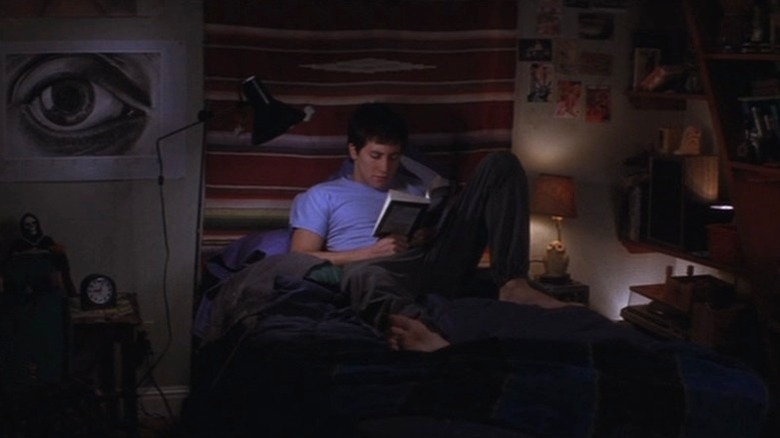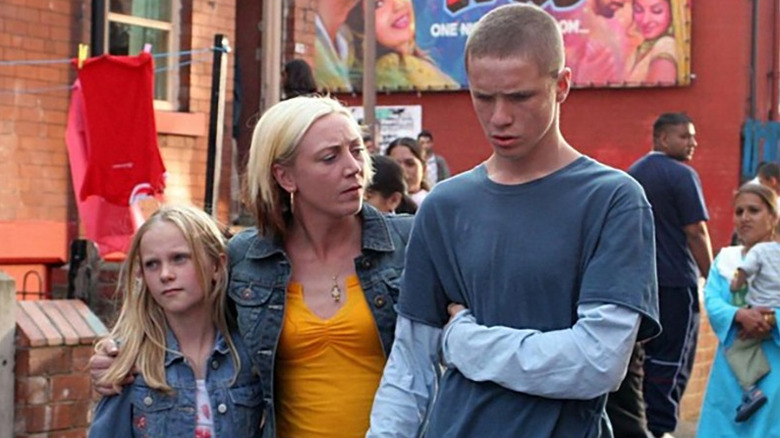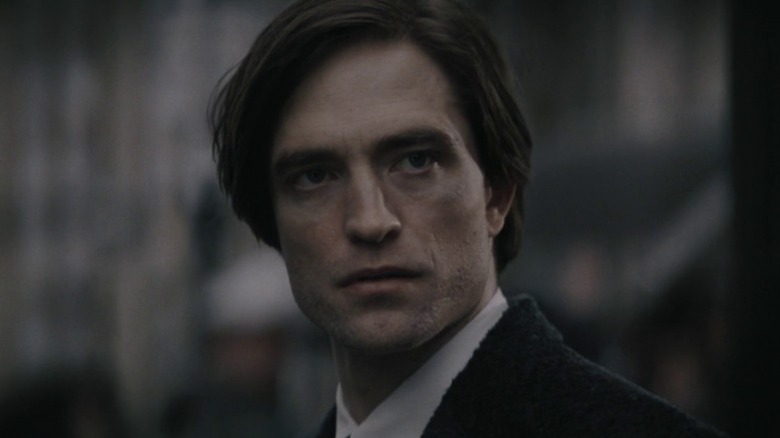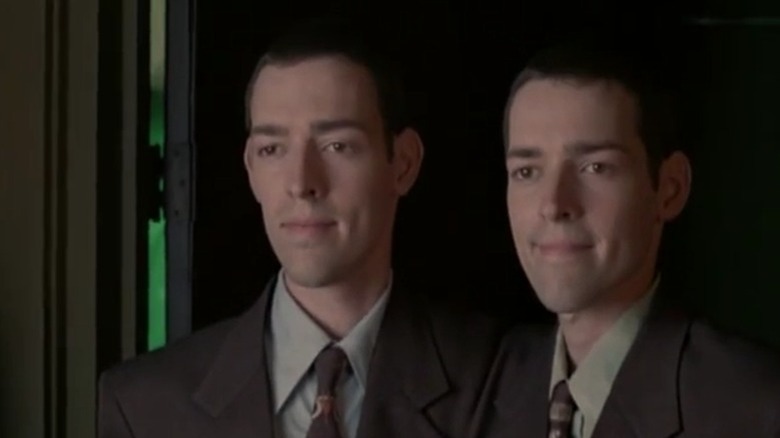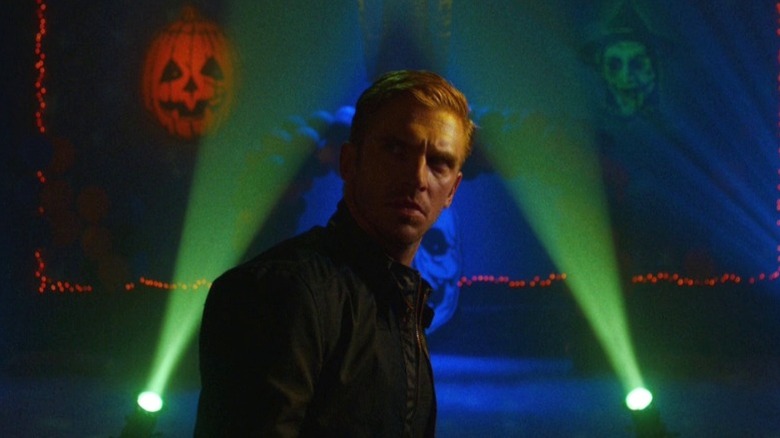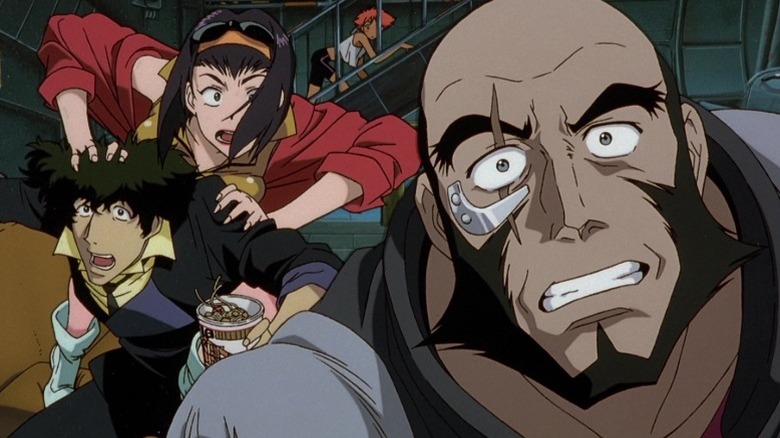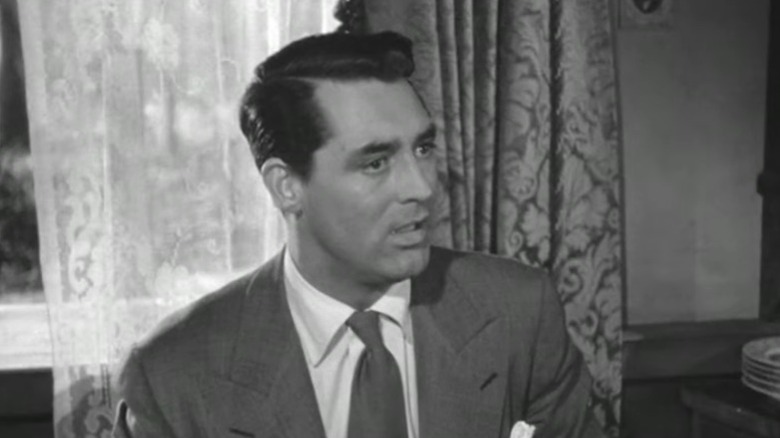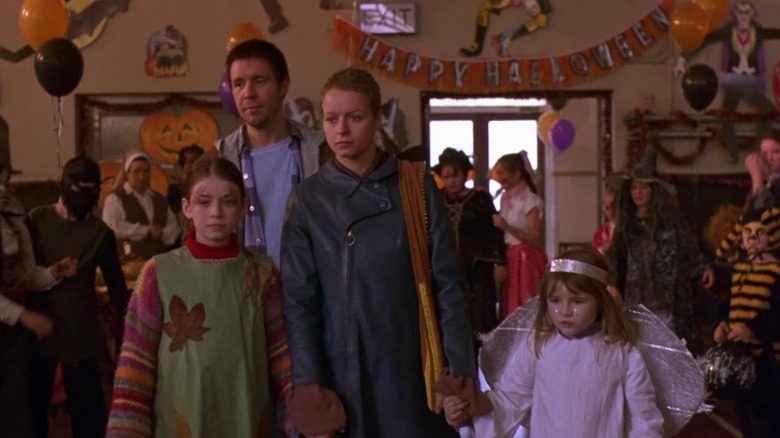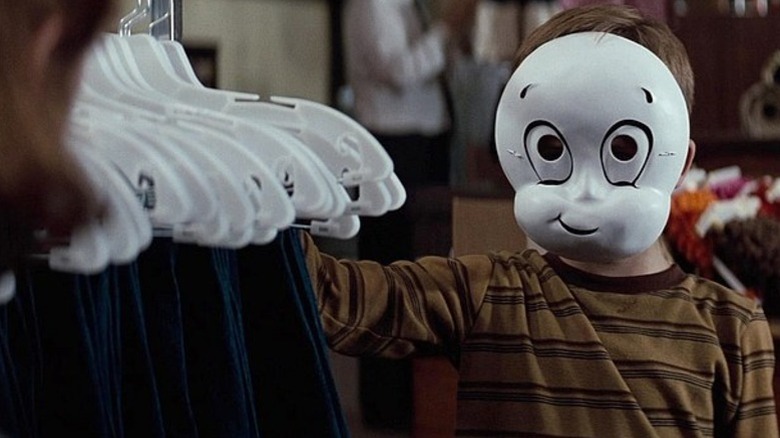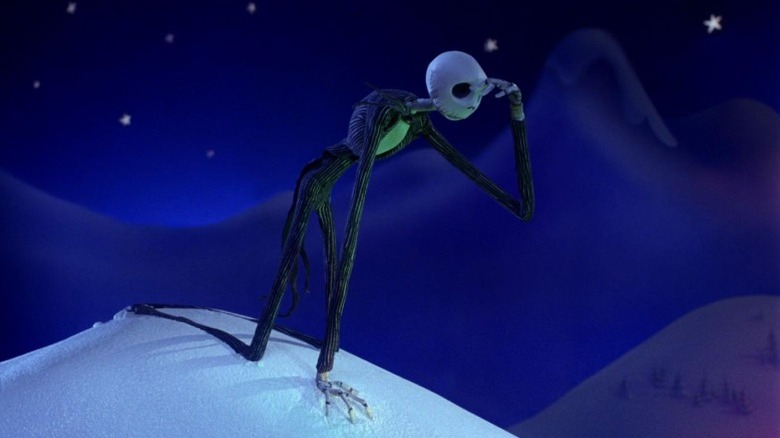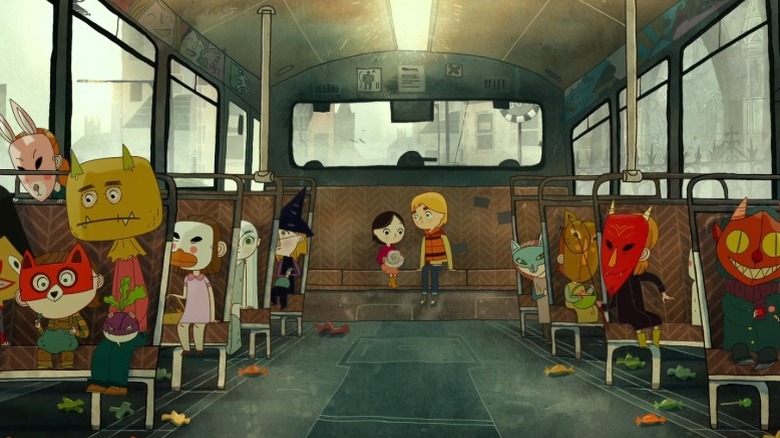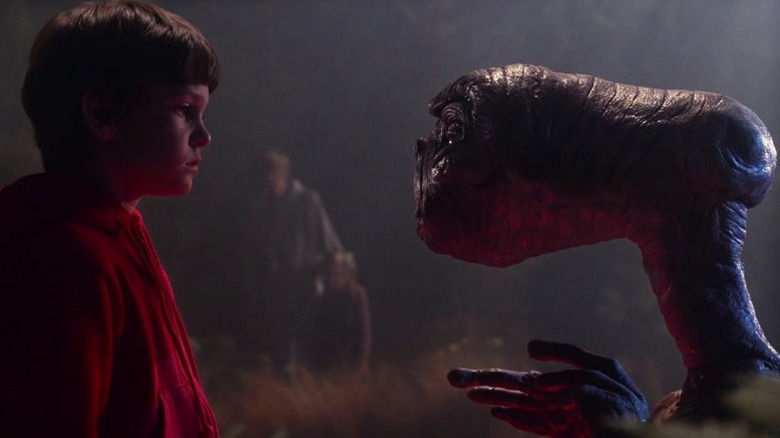12 Best Non-Horror Movies Set On Halloween, Ranked
Of all calendar subdivisions, Halloween season may be the single most conducive to fruitful movie-watching projects. No other holiday offers such a perfect built-in excuse for spending a whole month watching movies of a specific genre. Maybe Valentine's Day, but I digress.
But what of the Halloween-appropriate movies that aren't horror films? There are actually many of those out there, including ones that brush up against October 31 in passing ("Mean Girls," et cetera), as well as ones that feature it in a central dramatic, thematic, and/or aesthetic capacity. Here, we've ranked the 12 best non-horror movies that incorporate Halloween — either the day itself or the season — as a crucial, non-negotiable backdrop for the benefit of anyone who wants to celebrate spooky season through movie-watching but would prefer to avoid the scary stuff.
Donnie Darko
One of the definitive cult films of the 21st century, Richard Kelly's "Donnie Darko" is still the subject of as much fervent analysis, speculation, and fascination as it was upon its release in 2001. Written by Kelly himself, "Donnie Darko" tells the story of the titular troubled teen (played by Jake Gyllenhaal), whose life begins to change dramatically after he narrowly escapes a freak jet engine crash due to a sleepwalking episode. Plagued by visions of the mysterious Frank the Rabbit (James Duval), who insists that the world will end within less than a month, Donnie starts losing his grip on reality, while being manipulated into committing a series of crimes that dramatically disrupt life in his suburban town.
In addition to being one of the works that catapulted both Gyllenhaal and his co-star Jena Malone into stardom, "Donnie Darko" is one of those deeply momentous and influential movies that seem to create a before-and-after effect in the indie cinema landscape. Its evocation of adolescent malaise left a mark on everything from 2000s mindscrew thrillers to nu metal videos to the later surge of angst-driven YA literature, and its tale of a lost young man navigating a surreal nightmare of his own making remains enormously effective. Plus, it's set entirely during October and features a nifty Halloween climax — which makes it perfect non-horror viewing for spooky season.
Mischief Night
Several cultures in the English-speaking world celebrate what is known as "Mischief Night" — a day dedicated to pranks, clubbing, gleeful vandalism, and general rule-breaking, usually observed on October 30. There have been a number of films centered around this informal holiday, but 2006's "Mischief Night" is particularly notable as a spunky, delightful slice of Halloween counterprogramming.
Written and directed by Penny Woolcock, "Mischief Night" is the third film in a trilogy following the character of Tina Crabtree (Kelli Hollis), a resident in a rundown estate in Leeds, England. Where the first two films, "Tina Goes Shopping" and "Tina Takes a Break," were both made-for-TV productions that originally aired on Channel 4, "Mischief Night" broadens the length, the production values, and the scope of the narrative — while retaining its predecessors' emphasis on the everyday reality of working-class Leeds residents.
"Mischief Night" takes a look at the segregation between white and Asian citizens in the Leeds suburbs, focusing particularly on the relationship between Tina's white family and the neighboring Khan family. Over the course of the titular pre-Halloween night, friendships, affections, animosities, and political tensions all come to a head amid an effervescent burst of partying, crime, hedonism, and chaos. It's an abrasive, naturalistic, oft-shocking, ultimately rewarding look at a rarely-depicted corner of the world, made in close collaboration with real-life Leeds residents, and impressively deft at balancing anarchic humor with pointed social commentary.
The Batman
Matt Reeves' "The Batman," the 12th and most recent iteration of the Caped Crusader to hit the big screen, opens on Halloween night. Gotham City mayor Don Mitchell Jr. (Rupert Penry-Jones) is murdered in his apartment by a masked assailant, who then escapes under heavy rain and disappears into the mass of costumed citizens celebrating the creepiest night of the year. That masked assailant, of course, turns out to be the Riddler (Paul Dano), a live-streaming serial killer who brings the "Batman" universe into discomfitingly close proximity with horror cinema — and the chosen date of the plot's inciting crime casts a shadow over everything that unfolds in the movie.
Written by Reeves and Peter Craig, "The Batman" may not take place entirely on Halloween, but it most certainly qualifies as a Halloween movie in the dedication with which it interrogates its protagonist's affiliation with the shadows. Notable as a back-to-basics effort that reinstated the vintage ethos of "Batman" stories as noir-inspired crime procedurals, "The Batman" presents a version of Bruce Wayne (Robert Pattinson) who is as tortured and haunted as he is obsessed with the righteousness of his cause — a sponge desperately graying itself out after two years of soaking in the bleakness of a broken city, unsure of how to really go about bettering it, let alone saving it. It's pretty much the perfect "Batman" movie for the 2020s, and it's also one of the best Bat-movies yet, from its drama down to its moody, Modern Gothic style.
Twin Falls Idaho
Arguably the most off-kilter film on this list, "Twin Falls Idaho" is a gem of American indie cinema that takes a sensitive and soulful look at a theme rarely explored in movies: the lives of conjoined twins. Francis (Mark Polish) and Blake Falls (Michael Polish) are two shy brothers joined at the hip who, while staying in a hotel during a quest to find their estranged birth mother, hire the services of prostitute Penny (Michele Hicks). She's initially repulsed by them and runs off but later returns to retrieve her purse, and she winds up forming a connection with the brothers.
Written by its real-life twin protagonists themselves and directed by Michael, "Twin Falls Idaho" pivots on Penny's decision to take the brothers with her to a Halloween costume party, where they can avoid societal judgment by pretending to be wearing a costume. With no trace of sensationalism or othering, the film burrows deep into the psychological landscape of Francis and Blake's lives, Penny's gradual understanding and acceptance of them, and the emotional and existential conflict that eventually sets in when Francis' deteriorating health calls for an urgent separation surgery. It's the kind of singular, intimate, small-scale movie that the Sundance Film Festival used to offer up in spades before it became a treasure hunt for the next "Little Miss Sunshine"-esque breakout megahit — and it incorporates Halloween's spirit of delight and empowerment in nonconformity like few other films.
The Guest
Adam Wingard is, of course, one of the most notorious horror filmmakers of the 21st century. On top of having his career launched by "You're Next," Wingard has also incorporated enough love for gonzo horror into the DNA of his style that even his non-scary films feel like they're teetering on the edge of shrieking panic. 2014's "The Guest," for instance, is a twisty action thriller that only a horror director could make.
In the plot, scripted by Wingard's habitual collaborator Simon Barrett, the Peterson family is reeling from the death of their eldest, Caleb, in the war in Afghanistan. One day, they are visited by one David Collins (Dan Stevens), who introduces himself as Caleb's former best friend from the army, and claims that he wants to help out the family in any way he can in the wake of their loss.
David is invited to stay for a while, and begins to both impress and alarm the Petersons with his dauntless, direct, often violent way of dealing with problems like homophobic bullying and aggressive exes. Then, a series of deaths around town raise the possibility that maybe David isn't being entirely honest about his past. It's an intense, pulpy, stylish ride that vibrates with a deliciously wicked energy. And it's entirely set during Halloween season, parties and decorations and all.
Cowboy Bebop: The Movie
Anyone with even a passing knowledge of anime history knows that Sunrise's "Cowboy Bebop" is one of the most acclaimed anime series of all time — and its 2001 feature film adaptation similarly figures among the best of its kind. Written by Keiko Nobumoto and directed by Shinichirō Watanabe (both primary creative forces of the original series), "Cowboy Bebop: The Movie" takes place between episodes 22 and 23 of the show, and it's sometimes titled "Cowboy Bebop: Heaven's Door" in English.
Fittingly enough, given that the show's team already endeavored to make every episode feel unique, "Cowboy Bebop: The Movie" doesn't even try to be more than a business-as-usual "Cowboy Bebop" episode — and that, as it turns out, is plenty enough to make it fantastic. Set in 2071, like the series, the show begins with a terrorist bombing on Mars a few days before Halloween, which releases a deadly virus into the atmosphere. The Mars government offers the highest bounty ever for the person responsible, and the Bebop crew — consisting of Spike Spiegel (Kōichi Yamadera), Faye Valentine (Megumi Hayashibara), Jet Black (Unshō Ishizuka), and Edward Wong (Aoi Tada) — sets out to catch them. It's essentially an opportunity to see what "Cowboy Bebop'"s unmatched vision of retro-futuristic space mayhem looks like ballooned to cinema budget, and the results are stunning. It's great sci-fi, great blockbuster adventure, great understated drama, and great Halloween viewing all rolled into one.
Arsenic and Old Lace
Anyone who's used to thinking of Frank Capra as a maker of sweet, feel-good crowd-pleasers owes it to themselves to see what he did in "Arsenic and Old Lace." Adapted from the eponymous, massively successful Broadway play by Joseph Kesselring, with a screenplay penned by Julius J. Epstein and Philip G. Epstein, "Arsenic and Old Lace" is one of the most nonchalantly nasty films of Golden Age Hollywood, a black comedy with enough layers of snickering wickedness to also qualify as a screwball comedy.
Take a gander at the premise: Marriage-averse theater critic and author Mortimer Brewster (Cary Grant, who landed his role in an unusual way) makes the unexpected decision to marry Elaine Harper (Priscilla Lane) on Halloween day, thereby placing his reputation at risk. While Elaine goes off to share the news with her family, Mortimer travels to the estate of his two maiden aunts, Abby (Josephine Hull) and Martha (Jean Adair), to do the same.
Shortly after arriving, however, he discovers a hidden corpse and learns that his aunts have been maintaining a habit of murdering aging bachelors, ostensibly to put them out of their misery. Then, Mortimer's older brother Jonathan (Raymond Massey) also arrives — and, wouldn't you know it, he's also a secret serial killer. That Capra manages to spin this dark, Halloween-friendly setup into a delightfully buoyant and zippy comedy is a testament to his underrated brilliance as a cinematic craftsman, as well as to the strength of Kesselring's play.
In America
Jim Sheridan's "In America" is a sterling example of American independent drama at its very best. Like all the greatest examples of heartstring-tugging filmmaking, it's a movie that doesn't play coy about its intention to move viewers and instead makes that aspiration credible and honorable by couching the sentiment in honesty.
An Irish migrant to the United States himself, Sheridan co-wrote the screenplay with his daughters Naomi and Kirsten Sheridan — and the trio fills the story of the Sullivans, a poor Irish clan recently settled in a dilapidated Hell's Kitchen tenement, with so much fine-grained detail and hard realism that it's ultimately impossible to resist the film's play for tears. The excellent performances help, of course, beginning with Samantha Morton as the family's hard-working breadwinner, and also including Paddy Considine as the struggling actor husband and Djimon Hounsou as Mateo, a lonely Nigerian photographer who also lives in the tenement.
One of the film's central scenes is the Halloween sequence in which the two Sullivan daughters (Sarah and Emma Bolger) go trick-or-treating around the building, ultimately knocking on Mateo's door, in what turns out to be the beginning of a life-changing connection between him and the Irish family. It's a scene that casts Halloween in an unusual light, as an opportunity for warmth and camaraderie, in keeping with "In America'"s overall theme of hope and beauty sprouting out from harsh, unembellished circumstances.
A Perfect World
Clint Eastwood's pragmatic, classically disciplined, crowd-conscious (but not entirely crowd-pleasing) directorial style has yielded a sizable number of great films over the years, with his early '90s output as a particularly winning stretch — and the underrated crime drama "A Perfect World" is one of Eastwood's very best. Like much of his work as a filmmaker, it's a movie that initially lays out a fraught situation unsentimentally, but then dutifully looks for fits of aching sentiment within it, which hit harder for coming on the heels of so much restraint.
Scripted by John Lee Hancock (who would later direct Sandra Bullock in one of the least-deserving Oscar-winning performances ever in "The Blind Side"), the film follows Robert "Butch" Haynes (Kevin Costner), an escaped convict in 1963 Texas who kidnaps Phillip Perry (T. J. Lowther), the sheltered eight-year-old son of a staunch Jehovah's Witness mother (Jennifer Griffin). Initially intending to only use Phillip to facilitate his escape, Butch winds up developing an unexpected bond with the child as he introduces him to the outside world — all while Texas Rangers chief Red Garnett (Clint Eastwood) is chasing Butch down.
One of the paradoxical tastes of freedom that Phillip gets to have under captivity is partaking in Halloween celebrations for the first time, complete with a stolen Casper costume. It's a sequence that typifies Eastwood's approach to storytelling: mellowed out into American cultural tradition without quite accepting it uncritically and emotionally attuned without sidestepping its own economical form.
The Nightmare Before Christmas
If we're talking Halloween movies that aren't really inscribed into the horror genre, there may be no more mandatory inclusion than "The Nightmare Before Christmas," a movie that investigates the meaning of Halloween with a greater directness than any other non-scary movie in history — in addition to just being a fantastic movie all around. The only reason it's not even higher on this ranking is that the two films above it are all masterpieces as well.
Truth be told, "non-scary" is a bit of a misleading descriptor for a film that was as notable in 1993 as it is now for its ability to (healthily) frighten children. But the wonder of "The Nightmare Before Christmas" is that, years before the likes of "Coraline" and "James and the Giant Peach," it demonstrated Henry Selick's singular capacity for melding the morbid and grotesque with the whimsical and dreamlike. (It also did as much for producer Tim Burton, who created the movie's story and characters and is frequently associated with it by audiences.)
With its story of Halloweentown residents, led by Jack Skellington (Chris Sarandon when speaking, Danny Elfman when singing), infiltrating Christmas Town for kicks and wreaking more havoc than they bargained for, the movie offers up one of the most fully-realized aesthetic visions in the history of animated film, all in service of a doubly fitting holiday watch. And the Danny Elfman-penned songs are a spectacle all their own.
Song of the Sea
Ireland's Cartoon Saloon has been at the vanguard of English-language animated cinema for over a decade now, creating gem after gem with its impassioned insistence on the continued worth of traditional animation in a CGI-saturated industry. 2014's "Song of the Sea" is part of the studio's beloved Irish folklore trilogy — but, unlike the earlier "The Secret of Kells" and the later "Wolfwalkers," "Song of the Sea" is set in (relatively) modern times. Indeed, that accounts for a significant amount of its wonder.
Part of what makes the 1981-set "Song of the Sea" such a gorgeous, transporting feat of imagination is the way it interfaces ancient myth with the rhythms of contemporary life. In that sense, it also makes a huge difference that the Will Collins-scripted, Tomm Moore-directed film takes place during Halloween.
In the story, 10-year-old Ben (David Rawle) and his seemingly mute six-year-old sister Saoirse (Lucy O'Connell) are sent away from their island home to live in Dublin with their Granny (Fionnula Flanagan). Soon, Ben discovers that Saoirse is a selkie, a half-seal shapeshifter, and she may hold the key to saving a fairy folk that has been trapped in our world. Their adventure unfolds largely over one rainy Halloween day, with the seasonal decorations providing a contrast, at once secular and quietly eerie, with the magic lurking beneath the world's surface. It's an extraordinarily intelligent use of the genre in a thoroughly amazing film.
E.T. the Extra-Terrestrial
There's a reason Steven Spielberg's "E.T. the Extra-Terrestrial" is one of the most iconic movies of all time: In it, Spielberg, writer Melissa Mathison, composer John Williams, and other creatives came up with a perfect alchemy for children's cinema.
The story, widely known among audiences with even a passing knowledge of '80s pop culture, concerns an initially scary but friendly and lovable alien (voiced by Pat Welsh) who strays from his peers' plant-collecting expedition, and winds up in the backyard of 10-year-old Elliott Taylor (Henry Thomas). Troubled, lonely, and still bitter and confused about his parents' divorce, Elliott finds in E.T. the friend he's been looking for. Along with his older brother Michael (Robert MacNaughton) and little sister Gertie (Drew Barrymore), Elliott strives to hide and protect E.T. while he looks for a way to return home — but adults, as they are wont to, soon mess everything up.
One of Spielberg's most personal and wondrous films, "E.T." adopts a child's eye view of a country and a world long since divorced from any sense of innocence. It's a deeply poignant idea, perfectly expressed through the kids' use of Halloween as a distraction to help E.T. sneak through town and into the forest (a plot point that echoes the project's origin as a horror movie). It's a masterpiece about misplaced fear, unmanageable magic, overwhelming confusion, and the singular ability of children to brave through all of that without losing their compassion.
